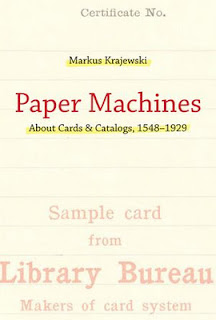 He applied the “Page 99 Test” to his new book, Paper Machines: About Cards & Catalogs, 1548-1929, and reported the following:
He applied the “Page 99 Test” to his new book, Paper Machines: About Cards & Catalogs, 1548-1929, and reported the following: A book is usually not considered as a machine, though it is common to use paper as one of the book’s basic elements and a machine to print its pages. If you open a book called Paper Machines on page 99, you may see a longer quote from a library furniture catalog from 1894 which depicts a paper machine. This page 99 first reads, no doubt, as one of the most boring passages of the whole narrative. However, the quote points to an incident where nothing less than a historical change within the long tradition of economical bookkeeping was invented. This crucial scene—which is described on the previous pages, 95ff.—took place in a company called Library Bureau and it was led by America’s foremost librarian of the 19th century, Melvil Dewey, the inventor of the famous library classification system which bears his name. Also, Dewey’s secretary plays a major role while using card catalogs not only for libraries but for her own commercial bookkeeping. Her visionary insight consisted of applying library furniture to financial transactions which led to the ubiquitous spread of card indexes on every office desk around 1900. However, this is only one small episode in a longer trajectory: Paper Machines outlines the story of the card index, as a library catalogue, as a collection of index cards for thinkers and as a tool for office efficiency from its primordial scene in 1548 (when a Zurich based polymath named Conrad Gesner starts thinking about cutting information into pieces) up to the beginning of the electrical era in the office and the new age of data processing, 1929. For the first time, this book deals with the history and analysis of a crucial cultural technique which has been neglected so far, though it operates on the very basis of our intellectual life: since freely moving data pieces around on paper slips is one way to cope with the notorious information overflow. Before the dawn of the computer age information was usually stored on paper, often kept in notebooks for further use. And the card index is, as Paper Machines argues meticulously, the obvious precursor of the computer as a data processing device.Learn more about Paper Machines at The MIT Press website.
Imaging the three following pieces of information written down on three index cards. You may shuffle them, you may store them in your own modern card index (i.e. your computer), or you may use them as the nucleus of your own new(s) story:
Paper Machines unfolds the history of cutting those papers of thinking in pieces instead of keeping them in bound form, and how those mobile elements provide a specific advantage not only for data processing purposes or for library use. Furthermore paper slips serve as very basic as well as productive tools of thinking for both more efficient handling and—what is more—for scholarly purposes.
Paper Machines makes a strong contribution to a new historiographical approach, i.e. developing an argument in an entertaining as well as theoretically challenging manner. That's how media theory is fun.
Paper Machines tells the long story of the card index / index card from the Early Modern Period to the dawning age of electronic communication in an unexpectedly amusing way: as a history of failures. An astonishing story, not only for librarians, bibliophiles and historians of the art of unelectronic data processing.
--Marshal Zeringue



